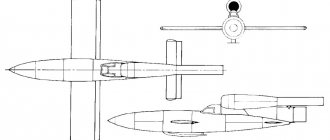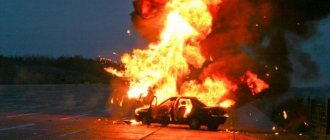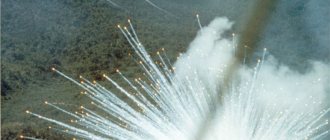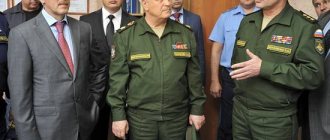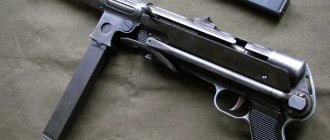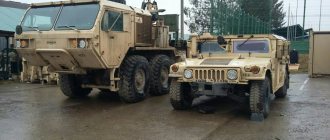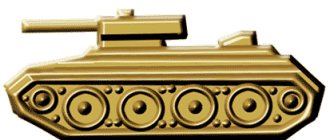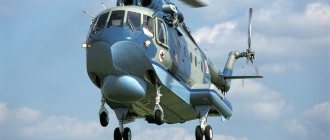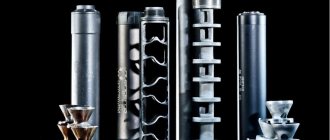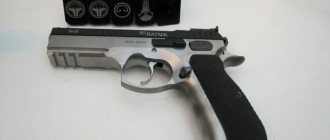Air bomb AN602 or “Tsar Bomba” (USSR) - the most powerful nuclear explosive device in the history of mankind
Air bomb GBU-43 “Mother of all bombs” (USA)
Bombs
- the name of a wide range of types of ammunition and explosive devices. Most bombs are designed to destroy ground, underground and sea targets (during the Second World War, the USSR also used small bombs designed to destroy air targets - they were called aircraft grenades), but there are also numerous classes of bombs (mostly aircraft) to deal with other tasks (setting up smoke screens, illuminating the area, photographing, signaling, propaganda and training purposes).
Etymology
| The reliability of this section of the article has been questioned. You must verify the accuracy of the facts stated in this section. There may be explanations on the talk page. |
The Russian word “bomb” comes from the Greek. βόμβος (bombos), an onomatopoeia, an onomatopoeic word that in Greek had approximately the same meaning as the word “babakh” in Russian. In the European group of languages, the term has the same root “bomb” (German bombe
, English
bomb
, fr.
bombe
, Spanish
bomba
), the source of which, in turn, is Lat.
bombus
, Latin analogue of Greek onomatopoeia.
According to one hypothesis, the term was originally associated with battering guns, which first made a terrible roar, and only then caused destruction. Subsequently, with the improvement of warfare technologies, the logical chain of war - roar - destruction
became associated with other types of weapons. The term experienced a rebirth at the end of the 14th and beginning of the 15th centuries, when gunpowder entered the arena of war. At that time, the technical effect of its use was negligible (especially in comparison with the mechanical types of throwing weapons that had reached perfection), but the roar it produced was an extraordinary phenomenon and often had an effect on the enemy comparable to a shower of arrows.
Multitasking
In the post-war period, bomber aircraft armed themselves with more substantial instruments - bombs weighing up to five hundred kilograms. Such projectiles, which have gone through several stages of modernization, are still used by the Russian Aerospace Forces today, including in Syria. Precision strikes with concrete-piercing aerial bombs destroy fortified terrorist command posts and especially protected bunkers, underground weapons depots and militant communications.
Concrete-piercing shells differ from fragmentation or armor-piercing shells primarily in their thick, reinforced walls and special body strength. The projectile must enter the reinforced concrete mass at a right angle and at high speed. The fuse fires with a delay. The shell explodes directly in the thickness of the concrete or, having pierced through the wall of the fortification, inside the structure. Therefore, in artillery, only powerful large-caliber guns are suitable for destroying strong concrete structures.
As for aviation, the Russian Aerospace Forces have at its disposal several types of concrete-piercing bombs - free-falling and equipped with jet boosters. A simple BetAB-500 can be carried by almost any modern attack aircraft. It is dropped from a height of several thousand meters so that the ammunition has time to develop enormous speed and obtain a supply of kinetic energy sufficient to completely penetrate the barrier. A 500-kilogram bomb freely passes through a ceiling of pure concrete up to a meter thick or penetrates up to three meters of soil.
Its modification - BetAB-500ShP - is equipped with a parachute for stabilization in flight, and a jet engine provides additional acceleration near the ground. Penetration ability is approximately the same, but due to the special design, the bomb can be dropped from low altitudes. In addition, it is much more accurate than the regular BetAB-500.
One of the most modern shells in the arsenal of the Russian Aerospace Forces, the RBK-500U cluster concrete-piercing bomb, consists of ten combat elements and is especially effective for hitting area targets. Small shells scatter over a radius of several tens of meters, destroying runways, airfield taxiways, and highways.
| Russian Su-24 front-line bombers at the Khmeimim airbase l. |
| Source: RIA Novosti / Ramil Sitdikov |
Story
In the period up to and including the First World War, bombs were heavy explosive (in modern terminology - high-explosive and high-explosive fragmentation) artillery shells intended for firing from mortars of all calibers (but not mortars!), heavy howitzers and heavy guns, as well as naval bombing guns (however, the latter fell out of use in the 19th century)[1]. The bomb for a smoothbore gun was a hollow core filled with gunpowder, with a wooden spacer tube, also filled with gunpowder, inserted into a hole - a “point”; around the hole there were two brackets (“ears”), by which the bomb was lifted with special hooks when loading. It was inserted into the barrel with the remote tube down and ignited by powder gases. In the Russian Empire, a bomb was considered a howitzer and cannon explosive projectile weighing 1 pound (for a smoothbore gun firing round cannonballs, this roughly corresponds to a caliber of 196 mm) or more (shells weighing from 1 artillery pound to a pound were called grenades, and less than one artillery pound - bullets) and also, as already mentioned, a mortar shell of any weight (Russian artillery used mortars with a caliber of 1/4 pood (120 mm), 1/2 pood (152 mm), 1 pood (196 mm), 2 pood (245 mm .), 3 pounds (273 mm) and 5 pounds (333 mm).The bombs were invented by the Frenchman Bernard Renault d'Elisngare, nicknamed "Little Renault", and were first used in the French war with Algerian pirates to bomb the city of Algiers (October 28 1681). In Russia, they were first used in 1696 during the capture of the Turkish fortress of Azov. To carry large bombs, a special device was used, called a “ bomb carrier.”
»[2].
At the beginning of the twentieth century. Hand grenades and rifle (gun) grenades were also commonly called bombs or bombs. Moreover, the expression “airplane bomb” originally meant, in fact, a heavy hand grenade, which was dropped by pilots from airplanes. In addition, in the first half of the twentieth century. in Russia/USSR and Germany, bombs were also called over-caliber ammunition for field bomb launchers, and in Russia/USSR - sometimes also artillery (mortar) mines. Finally, there is widespread use of the term “bomb” to refer to improvised explosive devices (both projectile and engineered/planted or used as “surprise” mines) used by guerrillas and terrorists - although they are more accurately called hand grenades, mines and landmines.
At the beginning of the twentieth century. Some types of tanks for storing compressed gas, in particular, for “laughing gas” (nitrous oxide used for anesthesia), were also called bombs.
“The very best” among aerial bombs[ | ]
Conventional bombs[ | ]
Grand Slam
- PTAB-2.5-1.5 is the most popular aerial bomb of the USSR during the Great Patriotic War.
- FAB-100 - the main aerial bomb of the USSR during the Great Patriotic War.
- OFAB-250-270 is the most popular aerial bomb in military aviation in modern Russia. [1]
- FAB-5000NG (NG - from Nison Gelperin, chief designer of the bomb; a non-standard addition to the FAB-5000 index was adopted on the personal instructions of I.V. Stalin) - the most powerful and heaviest aerial bomb of the USSR during the Great Patriotic War. [2]
- FAB-9000M-54 is the heaviest (together with the armor-piercing BrAB-9000) and powerful non-nuclear aerial bomb in the USSR.
- Grand Slam (“Big Cotton”) is the most powerful (non-nuclear) and heaviest (9979 kg) aerial bomb of the Second World War.
- GBU-43/B Massive Ordnance Air Blast (MOAB) - “Massive shock wave ammunition”, common backronym: Mother Of All Bombs - “Mother of all bombs”; is the most powerful non-nuclear aerial bomb in the world (explosive mass - 8480 kg), brought into service. It was also the heaviest (9500 kg) guided aerial bomb in the world before the GBU-57 entered service and remains the most powerful of such bombs[4]. First used in combat conditions on April 13, 2017[5].
- GBU-57 Massive Ordnance Penetrator (MOP) - the heaviest (13609 kg) non-nuclear aerial bomb in history, brought into service (the first batch of 20 bombs was delivered to the United States Air Force in November 2011 G.). Also the heaviest guided aerial bomb in the world.
- The T-12 Cloudmaker is the heaviest (caliber - 43,600 pounds or 19,777 kg) non-nuclear (high-explosive) aerial bomb in history. Its body was used to manufacture the “uranium superbomb” Mk.18 and the thermonuclear aerial bomb Mk.17[6].
- ODAB-9000 [ source not specified 3693 days
] (“Kuzkin’s father”, “Daddy of all bombs”) - a high-power volumetric detonating aerial bomb. It is considered the most powerful non-nuclear weapon in the world (44,000 kg of TNT equivalent). - KhB-2000 is the heaviest chemical aerial bomb in history.
- GBU-44/B Viper Strike[en] (“Viper Strike”) is the smallest (19 kg) serial guided aerial bomb in the world.
- Small Tactical Munition (STM) Pyros (“Pyros”) is the smallest (6.13 kg) guided aerial bomb completed ready for delivery [7][8].
- Shadow Hawk (“Ghost Hawk”) is the smallest (5 kg) guided aerial bomb in the world[8].
- AO-8m6sch-fs is the smallest (6.67 kg) high-explosive aerial bomb in history.
- BLU-39 (chemical) is the smallest (about 82 grams) aerial bomb in history, brought into service.
- Bat bomb (“Mouse bomb”, incendiary) is the smallest (17 grams) aerial bomb in history (it was produced in an experimental series, but did not enter service). It was assumed that the carriers of these bombs would be bats dropped from airplanes in special self-unpacking containers.
Nuclear bombs[ | ]
- “Little Boy” (eng. Mk.I “Little Boy”) - the first nuclear bomb dropped on Japan (Hiroshima) on August 6, 1945 (8:15)[9].
- “Fat Man” (eng. Mk.III “Fat Man”) is the second nuclear bomb dropped on Japan (Nagasaki) on August 9, 1945 (11:02)[9].
- RDS-1 (“product 501”) is the first Soviet nuclear bomb[10].
- Mk.18 (“uranium superbomb”) is the most powerful (500 kilotons) and heaviest “classical” (only based on the nuclear decay reaction) nuclear bomb, brought to mass production and adoption. An analogue of the thermonuclear Mk.17, but in pure uranium equipment.
- RDS-6s (“product 6”) is the world’s first thermonuclear aerial bomb (and the world’s first thermonuclear munition in general)[10].
- Mk.17 is the most powerful (15 megatons) and heaviest (21,000 kg) thermonuclear bomb brought to mass production and adoption.
- AN602 (“Tsar Bomba”, “Kuzka’s Mother”, “Ivan”) is the most powerful (58.6 megatons) and heaviest (weight 26.5 tons with a parachute system) bomb in the history of mankind[11].
- Blue Danube was the first nuclear weapon adopted by the British Royal Air Force.
- Orange Herald (“Orange Herald”) is the most powerful (700 kilotons) tested ammunition, the energy release of which was provided entirely by the nuclear fission reaction.
Classification of bombs
Bombs are divided into:
K:Wikipedia:Articles without sources (type: not specified) [
source not specified 3704 days
]
- by purpose - for combat and non-combat. The latter include smoke, lighting, photo aircraft bombs (lighting for night photography), daytime (colored smoke) and night (colored fire) orientation-signal, orientation-sea (create a colored fluorescent spot on the water and colored fire; in the West, orientation-signal and orientation-naval aerial bombs have the general name of marker bombs), propaganda (stuffed with propaganda material), practical (for training bombing - do not contain explosives or contain a very small charge; practical aerial bombs that do not contain a charge are most often made of cement) and imitation (simulate nuclear bomb);
- by type of active material - conventional, nuclear, chemical, toxin, bacteriological (traditionally, bombs loaded with pathogenic viruses or their carriers also belong to the category of bacteriological, although strictly speaking a virus is not a bacterium);
- according to the nature of the damaging effect:
- fragmentation (damaging effect mainly from fragments);
- high-explosive fragmentation (fragmentation, high-explosive and high-explosive action; in the West such ammunition is called general purpose bombs);
- high-explosive (high-explosive and blasting action);
- penetrating high-explosive - they are also high-explosive thick-walled, they are also (Western designation) “seismic bombs” (with high explosive action);
- concrete-piercing (in the West such ammunition is called semi-armor-piercing) inert (does not contain an explosive charge, hitting the target only due to kinetic energy);
- concrete-breaking explosives (kinetic energy and blasting action);
- armor-piercing explosive (also with kinetic energy and blasting action, but having a more durable body);
- armor-piercing cumulative (cumulative jet);
- armor-piercing fragmentation / cumulative fragmentation (cumulative jet and fragments);
- armor-piercing based on the “shock core” principle;
- incendiary (flame and temperature);
- high-explosive incendiary (high-explosive and blasting action, flame and temperature);
- high-explosive fragmentation-incendiary (fragmentation, high-explosive and high-explosive action, flame and temperature);
- incendiary-smoke (damaging effects of flame and temperature; in addition, such a bomb produces smoke in the area);
- poisonous / chemical and toxin (poisonous substance / agent);
- poisonous smoke bombs (officially these bombs were called “smoking aviation poisonous smoke bombs”);
- fragmentation-poisonous/fragmentation-chemical (fragmentation and explosive agents);
- infectious action/bacteriological (directly by pathogenic microorganisms or their carriers from insects and small rodents);
- Conventional nuclear (at first called atomic) and thermonuclear bombs (initially in the USSR they were called atomic-hydrogen) are traditionally allocated to a separate category not only according to the active material, but also according to the damaging effect, although, strictly speaking, they should be considered high-explosive incendiary (with adjusted for additional damaging factors of a nuclear explosion - radioactive radiation and radioactive fallout) of ultra-high power. However, there are also “nuclear bombs of enhanced radiation” - their main damaging factor is radioactive radiation, specifically the neutron flux formed during the explosion (in connection with which such nuclear bombs received the common name “neutron”).
- Also in a separate category are volumetric detonating bombs (also known as volumetric explosion, thermobaric, vacuum and fuel bombs).
- by the nature of the target (this classification is not always applied) - for example, anti-bunker (Bunker Buster), anti-submarine, anti-tank and bridge bombs (the latter were intended for action on bridges and viaducts);
- according to the method of delivery to the target - rocket (the bomb in this case is used as a missile warhead), aviation, ship/boat, artillery;
- by mass, expressed in kilograms or pounds (for non-nuclear bombs) or power, expressed in kilotons/megatons) of TNT equivalent (for nuclear bombs). It should be noted that the caliber of a non-nuclear bomb is not its actual weight, but its correspondence to the dimensions of a certain standard weapon (which is usually a high-explosive bomb of the same caliber). The discrepancy between caliber and weight can be quite large - for example, the SAB-50-15 illumination aerial bomb had a 50-kg caliber and weighed only 14.4-14.8 kg (a discrepancy of 3.5 times). On the other hand, the FAB-1500-2600TS aerial bomb (TS - “thick-walled”) has a 1500-kg caliber and weighs as much as 2600 kg (the discrepancy is more than 1.7 times);
- according to the design of the warhead - monoblock, modular and cluster (initially the latter were called “rotational dispersal aircraft bombs”/RRAB in the USSR).
- in terms of controllability - into uncontrollable (free-falling, in Western terminology - gravitational - and gliding) and controlled (adjustable).
Jet depth charges, in fact - unguided missiles with a warhead in the form of a depth charge, which are in service with the Russian Navy and the Navy of a number of other countries are classified according to their firing range (in hundreds of meters) - for example, the RSL-60 (RGB - jet depth charge) is fired (however , more correctly, it is launched) from the RBU-6000 rocket launcher at a range of up to 6000 m, RGB-10 from the RBU-1000 - at 1000 m, etc.
Non-nuclear monsters of the nuclear age
Soon, however, the progress of nuclear chargers made this kind of ammunition unnecessary. By the mid-1950s, both main participants in the nuclear race received relatively compact “anti-bunker” special ammunition. The development of super-heavy aerial bombs with conventional ammunition, however, continued.m
In the early 1950s, the FAB-9000 bomb, designed to destroy large industrial structures and railway junctions, entered service in the USSR.
In the 1980s, it was used in Afghanistan to block mountain roads used by spooks. The explosion of this bomb led to strong landslides, making it impossible to pass through the gorges.
FAB-9000
In the United States in the 1960s, a 6,800-kilogram BLU-82/B bomb was developed, which received the unofficial name Daisy Cutter (“daisy cutter”).
The task of this bomb, exploding at a short distance from the earth's surface, was not so much to destroy enemy personnel or fortifications, but to quickly clear the area for landing helicopters in the tropical thickets of Vietnam.
Where traditional methods would have required many hours of work by dozens of people with axes, machetes and chainsaws, the use of such ammunition made it possible to equip the site in a couple of passes of an MS-130 transport aircraft specially equipped to drop this bomb.
Since this specific bomb was not intended to destroy any capital structures, the walls of its body were made quite thin, and the weight of the explosive exceeded 5,700 kilograms - almost one and a half tons more than the heavier Soviet FAB-9000.
Soon, however, this specific product was replaced by a new generation of bombs. Volumetric explosion ammunition, also known as volumetric detonating ammunition, using the spraying of a flammable substance in the form of an aerosol and detonation of the resulting gas-air cloud, made it possible to effectively “clear” thickets for landing operations in the jungle, as well as combat fortifications: a gas mixture flowing into cracks and embrasures , was blown up, destroying soldiers in shelters more reliably than the shock wave of standard high-explosive bombs that went off outside.
Volumetric detonating aerial bombs (ODAB) of various weights and designs were actively developed in both the USA and the USSR, and were also actively used in local conflicts.
In particular, the USSR and Russian Air Forces used ODAB in Afghanistan and both Chechen wars, and the US Air Force used similar ammunition in Afghanistan already in the 2000s.
Notes
- Great Soviet Encyclopedia: [in 30 volumes] / ch. ed. A. M. Prokhorov. — 3rd ed. - M.: Soviet Encyclopedia, 1969-1978.
- Bomb carrier // Military encyclopedia: [in 18 volumes] / ed. V. F. Novitsky [and others]. - St. Petersburg. ; [M.]: Type. t-va I.V. Sytin, 1911-1915.
| : Incorrect or missing image | This article lacks links to sources of information. Information must be verifiable, otherwise it may be questioned and deleted. You may edit this article to include links to authoritative sources. This mark is set January 16, 2020 . |
K:Wikipedia:Articles without sources (type: not specified)
Steel sledgehammer
Soviet artillerymen fired concrete-piercing shells in the winter war with Finland. After the first unsuccessful attempts to break through the Mannerheim Line and heavy losses of personnel, the command decided to actively use artillery before committing armored vehicles and infantry to battle. The 203-mm B-4 howitzers were especially effective against reinforced concrete fortifications on the Karelian Isthmus.
Their concrete-piercing shells literally bit into two-meter walls and multi-layered armor of bunkers, turning pillboxes and bunkers into shapeless piles of construction debris. These giants destroyed several hundred expensive structures, and the Finns even nicknamed the B-4 howitzer “Stalin’s sledgehammer” for its power and destructiveness.
The success of concrete-piercing artillery inspired the Soviet military and engineers to develop similar aircraft weapons. The first domestic concrete-piercing bomb, BetAB-150DS, was based on the same 203-mm artillery shell. The warhead of the bomb weighed more than one hundred kilograms, and the jet upper stage gave it additional acceleration as it approached the target. BetAB-150 penetrated into the rock to a depth of more than one and a half meters, forming a crater with a diameter of up to two meters.
| Red Army soldiers fire at Finnish fortifications. |
| Source: RIA Novosti / RIA Novosti |
Excerpt characterizing the Bomb
Petya was standing at the door when Denisov said this. Petya crawled between the officers and came close to Denisov. “Let me kiss you, my dear,” he said. - Oh, how great! how good! - And, having kissed Denisov, he ran into the yard. - Bosse! Vincent! – Petya shouted, stopping at the door. - Who do you want, sir? - said a voice from the darkness. Petya answered that the boy was French, who was taken today. - A! Spring? - said the Cossack. His name Vincent has already been changed: the Cossacks - into Vesenny, and the men and soldiers - into Visenya. In both adaptations, this reminder of spring coincided with the idea of a young boy. “He was warming himself by the fire there.” Hey Visenya! Visenya! Spring! – voices and laughter were heard in the darkness. “And the boy is smart,” said the hussar standing next to Petya. “We fed him just now.” Passion was hungry! Footsteps were heard in the darkness and, bare feet splashing in the mud, the drummer approached the door. – Ah, c'est vous! - said Petya. – Voulez vous manger? “N’ayez pas peur, on ne vous fera pas de mal,” he added, timidly and affectionately touching his hand. - Entrez, entrez. [Oh, it's you! Are you hungry? Don't be afraid, they won't do anything to you. Come in, come in.] - Merci, monsieur, [Thank you, sir.] - answered the drummer in a trembling, almost childish voice and began to wipe his dirty feet on the threshold. Petya wanted to say a lot to the drummer, but he didn’t dare. He stood next to him in the hallway, shifting. Then in the darkness I took his hand and shook it. “Entrez, entrez,” he repeated only in a gentle whisper. “Oh, what should I do to him!” - Petya said to himself and, opening the door, let the boy pass by. When the drummer entered the hut, Petya sat away from him, considering it humiliating for himself to pay attention to him. He just felt the money in his pocket and was in doubt whether it would be a shame to give it to the drummer. From the drummer, who, on Denisov’s orders, was given vodka, mutton and whom Denisov ordered to dress in a Russian caftan, so that, without sending him away with the prisoners, he would be left with the party, Petya’s attention was diverted by the arrival of Dolokhov. Petya in the army heard many stories about the extraordinary courage and cruelty of Dolokhov with the French, and therefore, from the moment Dolokhov entered the hut, Petya, without taking his eyes off, looked at him and became more and more encouraged, twitching his head raised, so as not to be unworthy even of such a society as Dolokhov. Dolokhov’s appearance strangely struck Petya with its simplicity. Denisov dressed in a checkmen, wore a beard and on his chest the image of St. Nicholas the Wonderworker, and in his manner of speaking, in all his manners, he showed the peculiarity of his position. Dolokhov, on the contrary, previously, in Moscow, who wore a Persian suit, now had the appearance of the most prim Guards officer. His face was clean-shaven, he was dressed in a guards cotton frock coat with George in the buttonhole and a simple cap straight on. He took off his wet cloak in the corner and, going up to Denisov, without greeting anyone, immediately began asking about the matter. Denisov told him about the plans that large detachments had for their transport, and about sending Petya, and about how he responded to both generals. Then Denisov told everything he knew about the position of the French detachment. “That’s true, but you need to know what and how many troops,” said Dolokhov, “you will need to go.” Without knowing exactly how many there are, you cannot start the business. I like to do things carefully. Now, would any of the gentlemen want to go with me to their camp? I have my uniforms with me. - I, I... I will go with you! – Petya screamed. “You don’t need to go at all,” Denisov said, turning to Dolokhov, “and I won’t let him in for anything.” - That's great! - Petya cried out, - why shouldn’t I go?.. - Yes, because there is no need. “Well, excuse me, because... because... I’ll go, that’s all.” Will you take me? – he turned to Dolokhov. “Why…” answered Dolokhov absentmindedly, peering into the face of the French drummer. - How long have you had this young man? – he asked Denisov. - Today they took him, but he doesn’t know anything. I left it for myself. - Well, where are you putting the rest? - said Dolokhov. - How to where? I'm sending you under the guard! – Denisov suddenly blushed and cried out. “And I can boldly say that there is not a single person on my conscience.” Is it really right for you to send away a person under escort in a city, what to do, I will tell you, the honor of a soldier. “It’s decent for a young count of sixteen to say these pleasantries,” Dolokhov said with a cold grin, “but it’s time for you to leave it.” “Well, I’m not saying anything, I’m just saying that I will definitely go with you,” Petya said timidly. “And it’s time for you and me, brother, to give up these pleasantries,” Dolokhov continued, as if he found special pleasure in talking about this subject that irritated Denisov. - Well, why did you take this to you? - he said, shaking his head. - Then why do you feel sorry for him? After all, we know these receipts of yours. You send them a hundred people, and thirty will come. They will starve or be beaten. So is it all the same not to take them? Esaul, narrowing his bright eyes, nodded his head approvingly. - This is all shit, there’s nothing to discuss here. I don’t want to take it on my soul. You talk - pomg'ut. Well, hog'osho. Just not from me. Dolokhov laughed. “Who didn’t tell them to catch me twenty times?” But they will catch me and you, with your chivalry, anyway. – He paused. - However, we have to do something. Send my Cossack with a pack! I have two French uniforms. Well, are you coming with me? – he asked Petya. - I? Yes, yes, absolutely,” Petya cried, blushing almost to tears, looking at Denisov. Again, while Dolokhov was arguing with Denisov about what should be done with the prisoners, Petya felt awkward and hasty; but again I did not have time to fully understand what they were talking about. “If big, famous people think so, then it must be so, therefore it’s good,” he thought. “And most importantly, Denisov must not dare to think that I will obey him, that he can command me.” I will definitely go with Dolokhov to the French camp. He can do it and so can I.” To all of Denisov’s urgings not to travel, Petya replied that he, too, was used to doing everything carefully, and not Lazar’s at random, and that he never thought about danger to himself. “Because,” you yourself must agree, “if you don’t know correctly how many there are, the lives of maybe hundreds depend on it, but here we are alone, and then I really want this, and I will definitely, definitely go, you won’t stop me.” “, he said, “it will only get worse... Dressed in French greatcoats and shakos, Petya and Dolokhov drove to the clearing from which Denisov looked at the camp, and, leaving the forest in complete darkness, descended into the ravine. Having driven down, Dolokhov ordered the Cossacks accompanying him to wait here and rode at a fast trot along the road to the bridge. Petya, transfixed with excitement, rode next to him. “If we get caught, I won’t give up alive, I have a gun,” Petya whispered. “Don’t speak Russian,” Dolokhov said in a quick whisper, and at that same moment a cry was heard in the darkness: “Qui vive?” [Who's coming?] and the ringing of a gun. Blood rushed to Petya's face, and he grabbed the pistol. “Lanciers du sixieme, [Lancers of the sixth regiment.],” said Dolokhov, without shortening or increasing the horse’s stride. The black figure of a sentry stood on the bridge. – Mot d'ordre? [Feedback?] – Dolokhov held his horse and rode at a walk. – Dites donc, le colonel Gerard est ici? [Tell me, is Colonel Gerard here?] - he said. – Mot d'ordre! - Without answering, the sentry said, blocking the road. “Quand un officier fait sa ronde, les sentinelles ne demandent pas le mot d'ordre...” Dolokhov shouted, suddenly flushing, running his horse into the sentry. – Je vous demande si le colonel est ici? [When the officer goes around the chain, the sentries do not ask for feedback... I ask, is the colonel here?] And, without waiting for an answer from the guard who stood aside, Dolokhov walked up the hill at a walk. Noticing the black shadow of a man crossing the road, Dolokhov stopped this man and asked where the commander and officers were? This man, a soldier with a sack on his shoulder, stopped, came close to Dolokhov’s horse, touching it with his hand, and simply and friendlyly said that the commander and officers were higher on the mountain, on the right side, in the farm yard (that’s what he called the master’s estate). Having driven along the road, on both sides of which French conversation could be heard from the fires, Dolokhov turned into the courtyard of the manor’s house. Having passed through the gate, he dismounted from his horse and approached a large blazing fire, around which several people were sitting, talking loudly. Something was boiling in a pot on the edge, and a soldier in a cap and blue overcoat, kneeling, brightly illuminated by the fire, stirred it with a ramrod. “Oh, c'est un dur a cuire, [You can’t deal with this devil.]” said one of the officers sitting in the shadows on the opposite side of the fire. “Il les fera marcher les lapins... [He will get through them...],” said another with a laugh. Both fell silent, peering into the darkness at the sound of the steps of Dolokhov and Petya, approaching the fire with their horses. - Bonjour, messieurs! [Hello, gentlemen!] - Dolokhov said loudly and clearly. The officers stirred in the shadow of the fire, and one, a tall officer with a long neck, walked around the fire and approached Dolokhov. – C'est vous, Clement? - he said. – D'ou, diable... [Is that you, Clément? Where the hell...] - but he didn’t finish, having learned his mistake, and, frowning slightly, as if he were a stranger, he greeted Dolokhov, asking him how he could serve. Dolokhov said that he and a friend were catching up with their regiment, and asked, turning to everyone in general, if the officers knew anything about the sixth regiment. Nobody knew anything; and it seemed to Petya that the officers began to examine him and Dolokhov with hostility and suspicion. Everyone was silent for a few seconds. “Si vous comptez sur la soupe du soir, vous venez trop tard, [If you are counting on dinner, then you are late.],” said a voice from behind the fire with a restrained laugh. Dolokhov replied that they were full and that they needed to move on at night. He gave the horses to the soldier who was stirring the pot, and squatted down by the fire next to the long-necked officer. This officer, without taking his eyes off, looked at Dolokhov and asked him again: what regiment was he in? Dolokhov did not answer, as if he had not heard the question, and, lighting a short French pipe, which he took out of his pocket, asked the officers how safe the road was from the Cossacks ahead of them. “Les brigands sont partout, [These robbers are everywhere.],” answered the officer from behind the fire. Dolokhov said that the Cossacks were terrible only for such backward people as he and his comrade, but that the Cossacks probably did not dare to attack large detachments, he added questioningly. Nobody answered. “Well, now he’ll leave,” Petya thought every minute, standing in front of the fire and listening to his conversation. But Dolokhov again began the conversation that had stopped and directly began asking how many people they had in the battalion, how many battalions, how many prisoners. Asking about the captured Russians who were with their detachment, Dolokhov said:
Kill Saddam
The US Army has also learned to use concrete-piercing weapons. The most common is the GBU-28 guided bomb. It was developed specifically for Operation Desert Storm in the Persian Gulf in 1991. The American military then did not have enough weapons power to destroy government bunkers and command posts of the Iraqi army.
To speed up the work (industry was given only two weeks), 203-mm artillery gun barrels were used as the hull of the first versions of the GBU-28. During testing, a projectile weighing more than two tons and containing almost three hundred kilograms of explosives pierced a concrete floor up to six meters thick. And the accuracy of bombing was increased by laser guidance.
During Operation Desert Storm, the Americans dropped these hastily made bombs from F-111 bombers. In the bunkers and bomb shelters of Baghdad there were not only military personnel and government members, but also ordinary citizens. After several days of bombing, hundreds of dead and wounded were reported.
| Aircraft of the Russian Aerospace Forces carried out a targeted air strike with BetAB-500 concrete-piercing bombs on a bunker of IS militants (a terrorist organization banned in Russia) in the Syrian province of Latakia. |
| Source: RIA Novosti / Ministry of Defense of the Russian Federation |
The BLU-109/B has slightly less impressive dimensions. The bomb weighs about a ton and penetrates ceilings up to two meters thick. Its advantage is that the ammunition is equipped with smart guidance systems JDAM and Paveway III.
Other countries are actively developing concrete-piercing bombs. The Israeli Air Force, for example, is armed with the air-guided MRP-500, while French pilots use the penetrating BLU-107 Durandal. It is obvious that such weapons will not be retired soon.
Bombs. Aviation against fortifications. Russian concrete bombs
The enemy can hide his objects underground or place them under a reinforced concrete shelter. However, such protection no longer provides any guarantees. All developed air forces, including Russian ones, are armed with special concrete-piercing aerial bombs. Such weapons are designed to hit hardened targets that are protected from other aerial bombs. Due to a number of characteristic design features, concrete-piercing bombs are capable of going into the ground to great depths or breaking through solid layers of reinforced concrete. The history of Soviet and Russian concrete-piercing aerial bombs (in Russian terminology the abbreviation BETAB is used) began in the mid-thirties. At that time, Soviet engineers were working on a new class of aircraft weapons - the so-called. rocket bombs or "extra velocity" bombs. The result of the promising project was several armor-piercing and concrete-piercing bombs designed to attack ships and ground fortifications. A characteristic feature of the new classes of weapons was the presence of a solid-fuel rocket engine, which ensured the acceleration of the bomb before hitting the target.
From artillery to aviation
At the end of the thirties, the development of new aerial bombs that corresponded to current tasks was launched. Soon, Soviet designers created the BRAB-200DS and BETAB-150DS products. The latter became the first domestic aerial bomb, originally intended to combat concrete fortifications. It is curious that by the beginning of the forties, gunsmiths had found the most successful design solutions, some of which are still in use today.
Reconstruction of the appearance of the BETAB-150DS bomb. Drawing Russianarms.ru
203-mm artillery showed remarkable results in the fight against ship armor and concrete fortifications. For this reason, existing shells of the appropriate calibers became the basis for the new bombs. The concrete-piercing bomb was built on the basis of the G-620 projectile for a similar purpose. The latter weighed about 100 kg, had a thick-walled body and carried 15.36 kg of explosives. The projectile was equipped with a UT-36 shock tube. After some modification of the design and installation of additional units, the projectile turned into a bomb.
The new product was named BETAB-150DS - “concrete-piercing aerial bomb with a caliber of 150 kg.” The letters “DS” meant “additional speed” - this is how the presence of an accelerating solid propellant engine, designed to improve penetration and penetration characteristics, was indicated.
The new type of concrete-piercing bomb received a steel body, based on a part of an existing artillery shell. It had a pointed head with a cylindrical surface at the rear. At the rear of the projectile it was proposed to attach a cylindrical body with a solid propellant engine equipped with a TM-4 remote tube. An X-shaped tail was installed on it outside. It is curious that, unlike later BETABs, the first product of this class did not have a braking system.
The BETAB-150DS bomb had a length of just under 2.1 m with a body diameter of 203-205 mm. Curb weight – 165 kg. The rocket engine received a charge of solid fuel weighing 17.4 kg. After being dropped from the carrier aircraft, the bomb had to enter the calculated trajectory and turn on the engine, with the help of which a speed of 210 m/s was achieved. Tests have shown that when dropped onto a marble rock mass, a promising product can go to a depth of 1.65 m. After the explosion, a crater with a diameter of 1.8 and a depth of 2.5 m appeared in the rock mass.
Post-war BETAB-500 under the wing of an airplane. Photo Foxbat.ru
For a number of reasons, the first domestic concrete-piercing bomb did not make it in time for the Soviet-Finnish War. During this conflict, the Red Army was faced with the problem of numerous enemy fortifications, and at the same time could not count on real help from bomber aircraft. A new type of bomb was adopted for service already during the Great Patriotic War. According to available data, Soviet bombers regularly used such weapons against various enemy targets, and in most cases they were successful in hitting the target.
During the same period, a larger concrete-piercing bomb BETAB-750DS was developed. It was distinguished by its length increased to 4 m and was more similar to rocket-propelled mortar shells. However, serious problems arose in mastering the production of such weapons, and they were soon abandoned. As a result, only one serial product remained in the BETAB line.
Post-war family
Despite its fairly high characteristics, the BETAB-150DS bomb became obsolete over time. The development of ground defenses that took place during the recent war placed new demands on weapons. Combat aviation also did not stand still and now needed different weapons. In this regard, in the post-war period, a new family of concrete-piercing bombs was created that met current requirements.
According to research by military theorists, aircraft with concrete-piercing bombs now had to fight a number of new targets. In particular, such weapons were considered as a means of combating reinforced concrete shelters being built at the airfields of a potential enemy. At that time, destroying an aircraft in such a structure was only possible with the use of special bombs capable of breaking through a powerful ceiling.
Modern bomb BETAB-500ShP. A parachute container is installed on the rear part of the hull. Photo Militaryarms.ru
The first post-war BETAB samples were two products of relatively simple design. These were free-falling bombs BETAB-250 and BETAB-500 with a caliber of 250 and 500 kg, respectively. Modern materials and technologies were used to create new weapons. At the same time, a course was taken to simplify the design. In particular, the first post-war bombs were not equipped with a jet accelerator. However, even with this appearance they were able to solve the assigned tasks.
BETAB-250 and BETAB-500 had bodies of similar design, differing in size and volume. Both products were equipped with a rounded head part, behind which the cylindrical main part of the body was placed. The tail had a conical section with mounts for an X-shaped stabilizer. Due to their different dimensions and different masses, the two bombs had different proportions.
The smaller caliber bomb had a length of 1.86 m with a diameter of 285 mm and weighed 210 kg, of which 140 kg was the warhead. In terms of its characteristics, it was significantly superior to the old BETAB-150DS. The length of the BETAB-500 bomb reached 2.11 m with a diameter of 425 mm. Weight - 410 kg with a 380 kg warhead equipped with 75.8 kg of explosive. Larger ammunition could penetrate 500-1000 mm of reinforced concrete. The explosion, carried out with a slowdown of up to 30 s, left behind a crater with a diameter of 4-5 m.
Old ideas and new technologies
Concrete-piercing bombs BETAB-250 and BETAB-500 showed, in general, high performance, but over time they ceased to fully meet the requirements. First of all, there were complaints about the accuracy of hits and the real impact on the target. To maximize the acceleration of the bomb until it met the target, ensuring maximum penetration, bombing had to be carried out from high altitudes, which affected the accuracy of free-falling ammunition. In addition, the development of air defense forced aircraft to operate at low altitudes, and this also negatively affected the use of BETAB.
Cutaway model of the BETAB-500ShP bomb. Yellow indicates the warhead charge, brown indicates the fuse, and black indicates the solid propellant engine. The rear container contains a parachute. Photo Militaryarms.ru
Based on the results of regular research and design work, several new concrete-piercing bombs with different design features were created. They were developed using some elements of the BETAB-500 product, and therefore can be considered its deep modernization.
The ideas proposed back in the early forties were again implemented in the BETAB-500ShP (“assault, with a parachute”) bomb. It was based on the warhead of the existing BETAB-500, which was supplemented with new devices. A jet engine with 2.2 kg of solid fuel was placed in the same housing with the warhead, in its tail section. A drop container with a parachute with an area of 6 sq.m was installed behind the engine. The bomb had a length of 2.51 m and weighed 380 kg, of which 77 kg was the warhead charge.
The BETAB-500ShP product, after being dropped from the carrier, must release a braking parachute, the task of which is to change the flight path. To improve its combat qualities, an aerial bomb must fall on the target at a minimum angle to the vertical. After reaching a similar trajectory, the parachute system is reset and the solid fuel engine is started. With its help, the bomb develops sufficient speed in a minimum time. Due to design innovations, BETAB-500ShP can be used at heights of 170 m. At the same time, it penetrates up to 550 mm of reinforced concrete, and according to other characteristics it is comparable to the basic BETAB-500.
General view of the product BETAB-500SH. Noticeable are the engine nozzles pointing forward and the braking system in the folded position. Photo Russianarms.ru
An equally interesting version of a concrete-piercing bomb was proposed in the BETAB-500Sh (“assault”) project. In this case, it was proposed to attach a special combined-action braking device to the main body with a reinforced warhead and warhead. The large cylindrical body of the device housed a solid fuel engine, with its nozzles located at the front end. A so-called air brake was placed on the rear of the body. umbrella type, consisting of several movable planes. BETAB-500Sh had a length of 2.8 m with a diameter of 325 mm. Weight – 424 kg, charge – 70 kg. Like BETAB-500ShP, this product could be dropped from relatively low altitudes.
After separation from the carrier, BETAB-500SH is independently braked using a jet engine and an umbrella air brake. A drop in speed leads to a change in trajectory. The brake planes are then folded along the body. The bomb gets the opportunity to accelerate and fall on the target. According to known data, in terms of combat qualities, the BETAB-500Sh is similar to other weapons of its class.
Submunitions for cassettes
Concrete-piercing aerial bombs with a caliber of up to 500 kg are intended to destroy reinforced concrete structures, bunkers, shelters, etc. In this case, aviation may receive an order to destroy other targets built of concrete. Combat elements used with disposable cluster bombs were developed specifically to destroy runways and taxiways, highways and other area targets.
Such weapons are called RBK-500 BETAB and RBK-500U BETAB-M. The concrete-piercing element for such cassettes is a smaller version of a full-size aerial bomb. It has a cylindrical body of variable diameter with a conical head fairing, inside which the main charge in a reinforced body, as well as a solid propellant engine and a parachute are placed. A cassette of the RBK-500 type can accommodate ten such products.
Components of the RBC-500 BETAB system. On the left is a combat element, on the right is a bomb cluster with elements. Drawing Russianarms.ru
In terms of their operating principle, the submunitions of the RBK-500 BETAB product are similar to the full-size BETAB-500ShP aerial bombs. Immediately after leaving the cassette, the individual elements open their parachutes and enter a trajectory close to vertical. Next, the engine is started, with the help of which the element reaches the required falling speed. Despite their small size, such submunitions are capable of reliably hitting concrete runways or highways, leaving behind many fairly large craters.
BETAB in battle
The first domestic concrete-piercing bomb entered service at the very beginning of the Great Patriotic War, and therefore such products soon had to attack real targets. Being virtually the only representative of its class, BETAB-150DS was actively used until the very end of the war. Such weapons have accounted for many destroyed pillboxes, dugouts, bunkers and other enemy structures.
After the war, the Russian Air Force used weapons mainly on training grounds as part of exercises, but they still had to work on real targets. Bombs of the BETAB-500 family were actively used in Afghanistan to attack targets in the mountains. According to various sources, a number of such weapons were used later, during two wars in Chechnya. In all cases, the competent use of concrete-piercing bombs made it possible to destroy one or another protected object along with the enemies inside with almost one blow.
Aviation demonstrations using BETAB-500ShP bombs. The items on the left are still flying by parachute, the bombs on the right have already started their engines. Photo: Saidpvo.livejournal.com
At the end of September 2020, the Russian aerospace forces began an operation in Syria. By the end of autumn of the same year, it became known that in a number of cases Russian warplanes attacked enemy targets using concrete-piercing bombs. Once again, the high effectiveness of such weapons when used correctly was demonstrated.
Some tasks are too complex for general-purpose weapons, and in this case specialized systems must be used. The first domestic concrete-piercing aerial bombs were developed several decades ago specifically to combat fortified objects built in rocky soil or using reinforced concrete. Subsequently, this direction was developed, which led to a noticeable increase in the potential of combat aviation.
The Russian aerospace forces currently have several weapons in their arsenals to combat concrete structures. This means that a potential enemy may not rely on their shelters and bunkers. Modern weapons will reach him even under thick reinforced concrete.
Thermonuclear reaction
This reaction first became known to Soviet scientists studying a volumetric detonating explosion.
The principle of operation is to use nuclear fusion.
Compared to a nuclear explosion and a conventional reaction resulting from thermonuclear fusion, the power in theory is not limited up to a self-sustaining reaction over a long time (such theories are expressed when it is possible to test ammunition with a yield of more than 100 Megatons).
Thermonuclear reaction
